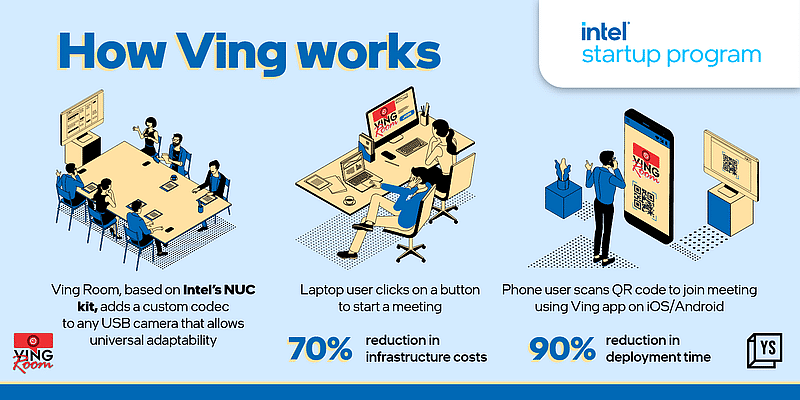“The camera is not getting connected.”
“Is the call on Teams or Zoom?”
“The remote isn’t working.”
“I can’t seem to figure this stuff out… call the IT guy.”
Nearly all of us have either heard or said these words in frustration at least once while collaborating across various meeting platforms in VC (video conference) rooms or on personal devices. Whether you’re working from home or the office, there’s no escaping those awkward first few moments trying to get everybody into the call — more so now, with hybrid work becoming the norm, and people connecting in from various locations.
Fortunately, there’s a company that has figured out how to make collaborating in virtual spaces as smooth as walking into an in-person meeting.
Ving is an all-in-one video conferencing solution that allows users to join into any virtual meeting platform using any device, or from any VC room that is equipped with any OEM camera.
“In the last two years of the pandemic, everyone’s been working from home. Video collaboration was pretty straightforward: you would receive a link, click on it, and get on with the meeting,” says Aditya Pisupati, Founder and CEO, Ving Hybrid, “But with offices opening up, there is always a group of people sitting in a meeting room in their office or a co-working space wanting to collaborate with folks working from home and other offices. Collaboration is complex in these scenarios and our solution makes this transition seamless.”
How does it work
Ving’s proprietary Operating System that powers the seamless collaboration across meeting platforms, devices, and cameras sits on an Intel NUC or any mini PC that is Intel -based. The combination of the Ving OS and the Intel hardware acts as an intelligent codec powering the VC rooms to connect into any meeting.
“Customers can connect any USB-based camera from, say, Cisco, Logitech, Jabra, or Poly among others, and our software converts that device into an intelligent, codec-based camera that can seamlessly dial into any meeting, with a uniform user experience. It’s as simple as one walking into a room, scanning a QR code on the TV screen and the meeting starts,” Aditya explains.
In addition to its ease of use, Aditya also says that the Ving Room solution offers wireless screen sharing, in-room signage, and unified dashboards for analytics and management – all under one licence. Ving helps reduce over 70% in infrastructure costs, with a 90% reduction in deployment time.
In one case, Ving was able to help a large EV organisation shore up expenses on VC rooms. Holding meetings with multiple teams in the office, on the field, and with external stakeholders, as well as coordinating across platforms and devices was a nightmare. Aditya elaborates, “Ving’s one-stop collaboration platform not only addressed their requirement but also offered wireless screen-sharing and in-room signage within their VC rooms, all under a single licence. The customer ended up saving up to Rs 3.5 lakh per room for their large rooms and up to Rs 1 lakh per room in their smaller rooms, on hardware and licensing costs.”
The genesis
“I come from a collaboration background and I’ve sold millions of dollars worth VC cameras and collaboration solutions. I’ve had sleepless nights with customers who say, ‘This doesn’t work with that, or that doesn’t work with this,’” Aditya says.
Aditya, who has over 19 years of experience in sales and product development, began working on Ving with his co-founder Amitabh Patney during their time together at Cisco, where Amitabh led the $170 million services business for Cisco India and SAARC.
What began in 2020 as an internal project to help customers have a smooth experience while collaborating on virtual platforms evolved into its own independent product company by 2021.
And before you ask, yes the Ving team does Ving themselves. “The core of the product was built during COVID when all of us were locked up at home, and we continue to be a distributed team, building, shipping, and deploying the solution. A product for the hybrid times, built the hybrid way,” Aditya quips.
Partnering with Intel
The duo teamed up with Intel to zero in on the edge compute device that offers a great experience to their end users. Aditya comments, “Ving’s proprietary operating system is built to work most effectively on Intel-based chipsets. The Intel Startup Program has been very useful in helping us fine-tune the OS to ensure the best experience is extended to the end user. Ving uses the Intel NUC kit as a default compute unit for all its deployments.”
Amitabh adds, “Ving’s robust, secure, and scalable platform clubbed with globally available Intel NUCs enable us to expand across geographies very quickly, and we are currently in the process to start operations in the North American markets.”
While expanding their user base is the next step for Ving, Aditya adds that their focus will be on adding more platforms and integrations to their ecosystem.
The Intel Startup Program: Enabling startups to scale their game-changing innovations
The Intel Startup Program is Intel India’s flagship program to engage with technology startups who have an IP or innovative solutions that have the potential to create impact on customers and align with Intel’s focus areas. The program is at the forefront of engaging with India’s startup ecosystem through high impact collaborations with the industry, academia and government, and runs multiple initiatives that are either vertically aligned or focused on emerging technologies.
It engages with startups that have a unique global or local value proposition to solve genuine customer problems, enabling them with domain and business expertise from the industry and mentorship from Intel.




![Read more about the article [Startup Bharat] How these two friends decided to tap into the food delivery space in rural West Bengal](https://blog.digitalsevaa.com/wp-content/uploads/2021/04/WhatsAppImage2021-04-01at12-1617273204762-300x150.jpg)





